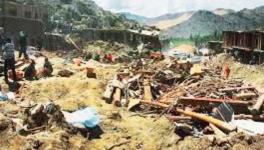Super Cyclone ‘Fani’ Reaches Odisha with Ferocious Winds of Speed 180 Kms Per Hour
Image for representational use only.Image Courtesy : The Indian Express
India’s east coast is witnessing the wrath of Fani, the super cyclone that first formed in the Bay of Bengal on April 25. Fani finally made the landfall today morning at around 8 o’clock in the city of Puri in Odisha. The landfall wind speed has been reported to be 175-180 kilometres per hour (km/hr) with occasional gusts of around 200 km/hr enabling it to be denoted as an Extremely Severe Cyclonic Storm and capable of devastation as a category 4 hurricane can do. Till now, 3 people have been reported to have died in a wall collapse due to the ravaging winds. Trees and electricity poles have been uprooted in Puri and Bhubaneswar, bringing the cities to a standstill.
Over 11 lakh people in the state of Odisha have been evacuated before the cyclone could make the landfall, thanks to the timely predictions done by the meteorological department. Almost 14 districts in the state of Odisha are in the path of the deadly cyclone that include Ganjam, Khurda, Naygarh, Bhadrak, Dhenkanal, etc. Apart from Odisha, the other state where large scale evacuations have been done is West Bengal, especially in the coastal areas neighbouring the Digha beach. The evacuated people have been housed in makeshift shelters in several places in Odisha and Bengal.
The Indian Meteorological Department (IMD) has said that the speed of the winds would come down within 24 hours and the cyclone would move North East of Odisha and Bengal. Neighbouring country Bangladesh is also predicted to fall under the destructive effects of Fani.
Also Read: Packing Furious Winds, Heavy Rains, Cyclone Fani Batters Odisha Coast
Difficulty in Predicting Fani
Fani has been difficult to predict, especially its track and speed. After forming as a low pressure area over equatorial Indian Ocean and South East of Bay of Bengal, and intensifying thereafter, Fani initially moved towards Sri Lanka and forecasters were thinking of a landfall somewhere in the Tamil Nadu coast. However, it changed its direction as well as pace and remained in the Bay of Bengal for almost eight days. While remaining in the Bay, the cyclone became more intense and developed as an extremely severe cyclonic storm. Storms of such kinds snuffle warm waters on the sea surface and become progressively intense.
The prediction of Fani’s landfall time was also difficult for the meteorologists. The IMD predicted that Fani will hit Odisha on May 4, then it was revised to be on evening of May 3. It was only yesterday that Fani made its landfall in afternoon of May 3, with its effects showing today.
India’s East Coast: A Cyclone Prone Area
Cyclonic devastations have become quite a regular phenomenon in India’s east coast as well as Bangladesh. The cyclone season can last from April to December and in the last couple of years, the phenomenon has scaled up. The primary factor of the cyclones remains to be the Bay of Bengal.
Memories have not quite fed away about the super cyclone that hit Odisha in October 1999 which left 10,000 people dead. At the time of landfall, the speed of the winds was 260 km/hr and the cyclone lasted for almost 30 hours. It was the most ravaging cyclone that India had ever experienced. Due to the lack of availability of prior predictions and a well acquainted disaster management system, India had very less chance of saving lives. But the country, since then, has developed its meteorological prediction infrastructure to a very decent level. Cyclone Titli last year and the Hud Hud in 2014 also caused widespread destruction.
The cyclone Ockhi in 2017 was also an unusual one. It started in the Bay of Bengal and changed its direction towards the Arabian Sea and made the landfall in Gujarat.
Get the latest reports & analysis with people's perspective on Protests, movements & deep analytical videos, discussions of the current affairs in your Telegram app. Subscribe to NewsClick's Telegram channel & get Real-Time updates on stories, as they get published on our website.
























